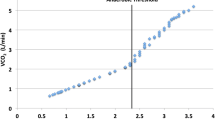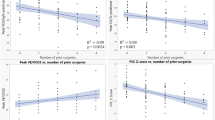Abstract
Adult congenital heart disease (ACHD) patients often require repeat cardiothoracic surgery, which may result in significant morbidity and mortality. Currently, there are few pre-operative risk assessment tools available. In the general adult population, pre-operative cardiopulmonary exercise testing (CPET) has a predictive value for post-operative morbidity and mortality following major non-cardiac surgery. The utility of CPET for risk assessment in ACHD patients requiring cardiothoracic surgery has not been evaluated. Retrospective chart review was conducted on 75 ACHD patients who underwent CPET less than 12 months prior to major cardiothoracic surgery at Children’s Hospital of Wisconsin. Minimally invasive procedures, cardiomyopathy, acquired heart disease, single ventricle physiology, and heart transplant patients were excluded. Demographic information, CPET results, and peri-operative surgical data were collected. The study population was 56% male with a median age of 25 years (17–58). Prolonged post-operative length of stay correlated with increased ventilatory efficiency slope (VE/\({V_{{\text{C}}{{\text{O}}_2}}}\) slope) (P = 0.007). Prolonged intubation time correlated with decreased peak HR (P = 0.008), decreased exercise time (P = 0.002), decreased heart rate response (P = 0.008) and decreased relative peak oxygen consumption (P = 0.034). Post-operative complications were documented in 59% of patients. While trends were noted between post-operative complications and some measurements of exercise capacity, none met statistical significance. Future studies may further define the relationship between exercise capacity and post-operative morbidity in ACHD patients.



Similar content being viewed by others
References
Marelli A, Ionescu-Ittu R, Mackie A, Guo L, Dendukuri N, Kaouache M (2014) Lifetime prevalence of congenital heart disease in the general population from 2000 to 2010. Circulation 130:749–756
Wren C, O’Sullivan J (2001) Survival with congenital heart disease and need for follow up later in life. Heart 85:438–443
Hoffman J, Kaplan S, Liberthson R (2004) Prevalence of congenital heart disease. Am Heart J 147:425–439
Verheugt C, Uiterwaal C, Grobbee D, Mulder B (2008) Long-term prognosis of congenital heart defects: a systematic review. Int J Cardiol 131:25–32
Zomer A, Verheugt C, Vaartjes I, Uiterwaal C, Langemeijer M, Koolbergen D, Hazekamp M, van Melle J, Konings T, Bellersen L, Grobbee D, Mulder B (2011) Surgery in adults with congenital heart disease. Circulation 124:2195–2201
Giamberti A, Chessa M, Abella R, Butera G, Carlucci C, Nuri H, Frigiola A, Ranucci M (2009) Morbidity and mortality risk factors in adults with congenital heart disease undergoing reoperations. Ann Thorac Surg 88:1284–1289
Holst K, Dearani J, Burkhart H, Connolly H, Warnes C, Li Z, Schaff H (2013) Risk factors and early outcomes of multiple reoperations in adults with congenital heart disease. Ann Thorac Surg 95:1383–1389
Wasserman K, Hansen J, Sue D, Stringer W, Whipp B (2012) Principles of exercise testing and interpretation. Lea & Febiger, Philadelphia
Older P, Hall A (2004) Clinical review: how to identify high-risk surgical patients. Crit Care 8:369–372
Iorio A, Magrì D, Paolillo S, Salvioni E, Di Lenarda A, Sinagra G, Agostoni P, Sciomer S (2013) Rationale for cardiopulmonary exercise test in the assessment of surgical risk. J Cardiovasc Med 14:254–261
Barakat H, Shahin Y, McCollum P, Chetter I (2015) Prediction of organ-specific complications following abdominal aortic aneurysm repair using cardiopulmonary exercise testing. Anaesthesia 70:679–685
Older P, Hall A, Hader R (1999) Cardiopulmonary exercise testing as a screening test for perioperative management of major surgery in the elderly. Chest 116:355–362
Snowden C, Prentis J, Anderson H, Roberts D, Randles D, Renton M, Manas D (2010) Submaximal cardiopulmonary exercise testing predicts complications and hospital length of stay in patients undergoing major elective surgery. Ann Surg 251:535–541
West M, Lythgoe D, Barben C, Noble L, Kemp G, Jack S, Grocott M (2014) Cardiopulmonary exercise variables are associated with postoperative morbidity after major colonic surgery: a prospective blinded observational study. Br J Anaesth 112:665–671
Wilson R, Davies S, Yates D, Redman J, Stone M (2010) Impaired functional capacity is associated with all-cause mortality after major elective intra-abdominal surgery. Br J Anaesth 105:297–303
Carlisle J, Swart M (2007) Mid-term survival after abdominal aortic aneurysm surgery predicted by cardiopulmonary exercise testing. Br J Surg 94:966–969
Smith T, Stonell C, Purkayastha S, Paraskevas P (2009) Cardiopulmonary exercise testing as a risk assessment method in non cardio-pulmonary surgery: a systematic review. Anaesthesia 64:883–893
Buber J, Rhodes J (2014) Exercise physiology and testing in adult patients with congenital heart disease. Heart Fail Clin 10:23–33
Rosenblum O, Katz U, Reuveny R, Williams C, Dubnov-Raz G (2015) Exercise performance in children and young adults after complete and incomplete repair of congenital heart disease. Pediatr Cardiol 36:1573–1581
Chaix M, Marcotte F, Dore A, Mongeon F, Mondésert B, Mercier L, Khairy P (2016) Risk and benefits of exercise training in adults with congenital heart disease. Can J Cardiol 32:459–466
Diller G, Dimopoulos K, Okonko D, Uebing A, Broberg C, Babu-Narayan S, Bayne S (2006) Heart rate response during exercise predicts survival in adults with congenital heart disease. J Am Coll Cardiol 48:1250–1256
Dimopoulos K, Okonko D, Diller G, Broberg C, Salukhe T, Babu-Narayan S, Li W, Uebing A, Bayne S, Wensel R, Piepoli M, Poole-Wilson P, Francis D, Gatzoulis M (2006) Abnormal ventilatory response to exercise in adults with congenital heart disease relates to cyanosis and predicts survival. Circulation 113:2796–2802
Inuzuka R, Diller G, Borgia F, Benson L, Tay E, Alonso-Gonzalez R, Silvia M, Charalambides M, Swan L, Dimopoulos K, Gatzoulis M (2012) Comprehensive use of cardiopulmonary exercise testing identifies adults with congenital heart disease at increased mortality risk in the medium term. Circulation 125:250–259
Swan I, Hillis W (2000) Exercise prescription in adults with congenital heart disease: a long way to go. Heart 83:685–687
Longmuir P, Brothers J, de Ferranti S, Hayman L, Van Hare G, Matherne P, Davis C, Joy E, McCrindle B (2013) Promotion of physical activity for children and adults with congenital heart disease—a scientific statement from the American Heart Association. Circulation 127:2147–2159
Jacobsen R, Ginde S, Mussatto K, Neubauer J, Earing M, Danduran M (2016) Can a home-based cardiac physical activity program improve the physical function quality of life in children with Fontan circulation? Congenit Heart Dis 11:175–182
Acknowledgements
The authors would like to acknowledge the Department of Pediatrics at the Children’s Hospital of Wisconsin and the Medical College of Wisconsin for their generous funding and resource provision, as well as Mary Krolikowski for her guidance throughout the execution of this project.
Author information
Authors and Affiliations
Corresponding author
Ethics declarations
Conflict of interest
The authors declare that they have no competing interests.
Ethical Approval
All procedures performed in studies involving human participants were in accordance with the ethical standards of the institutional research committee and with the 1964 Helsinki declaration and its later amendments or comparable ethical standards.
Informed Consent
Informed consent was deferred by the institutional review board given the retrospective nature of the project. All relevant patient data protections were observed according to HIPAA requirements.
Rights and permissions
About this article
Cite this article
Birkey, T., Dixon, J., Jacobsen, R. et al. Cardiopulmonary Exercise Testing for Surgical Risk Stratification in Adults with Congenital Heart Disease. Pediatr Cardiol 39, 1468–1475 (2018). https://doi.org/10.1007/s00246-018-1918-4
Received:
Accepted:
Published:
Issue Date:
DOI: https://doi.org/10.1007/s00246-018-1918-4




